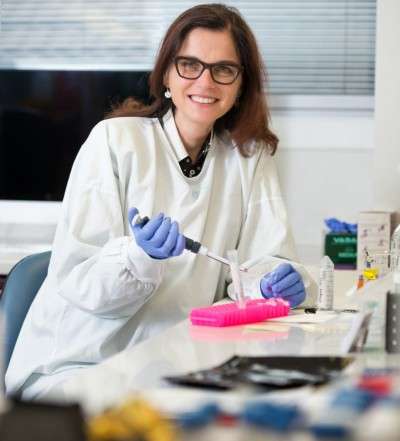Fresh hope for leukaemia cure

Monash researchers have uncovered the mechanism used by a common type of blood cancer to hide itself from the immune system.
The discovery breaks brand new ground in the search for a cure for Chronic Lymphocytic Leukaemia (CLL) - the most common adult leukaemia in the developed world. It affects B cells – white blood cells that in healthy people are responsible for producing antibodies to fight off infections. Most CLL patients die of other diseases because their bodies can no longer protect itself against them.
Lead researcher Professor Fabienne Mackay, from the Department of Immunology, said current leukaemia treatments involve killing all B cells – both cancerous and healthy – leaving patients even more vulnerable to secondary infections than they were due to the cancer.
"It turns out that cancer cells are very good at sabotaging the immune system, using various tricks that confuse immune cells and 'smoke screens' preventing immune cells from recognising the cancer," said Professor Mackay.
Professor Mackay, PhD candidate Damien Easton-Saulep and other researchers have pinpointed exactly how CLL confuses the immune system, and devised a way to stop it without destroying the patient's immune system.
Professor Mackay said their discovery paves the way for the creation of treatments that allow the body to naturally fight the cancer itself.
"The best weapon we have for fighting cancer is the immune system itself. It can sense the presence of an infection but also the emergence of a cancer," says Professor Mackay.
B cells rely on a particular protein – called 'B cell Activating Factor of the TNF Family', or 'BAFF' – to survive. Each B cell has three different kinds of receptor that detect the presence of BAFF in the blood, called TACI, BAFF-R and BCMA.
Researchers discovered that in CLL patients, the TACI receptors of cancerous B cells over-produce a protein called Interleukin-10 (IL-10), which tricks the immune system into thinking nothing is wrong with the body, allowing the cancer to thrive undetected.
"We found that when the receptor called TACI was blocked, it prevented the secretion of IL-10 without eliminating normal B cells," said Professor Mackay.
"Without IL-10, the tumour can no longer keep the immune system at bay, which means the patient's immune system can be 'kick-started' again to fight infections and cancers.
This is very exciting, because it means that the B cells stay alive and well to do their job in the immune system fighting other infections. It also means the over production of IL-10 is stopped, and the CLL tumour cells are now exposed to immune cells specialized in fighting cancers," Professor Mackay said.
Professor Mackay and her team believe their findings may be relevant across a number of types of cancer, potentially revolutionising the way they are treated.


















